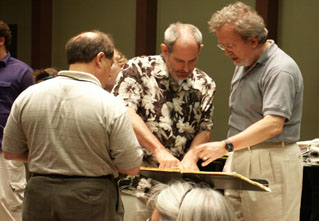We’re looking at all 5 steps over a couple of weeks. Step 1 was an overview, step 2 was about fundamentals, step 3 was about tactics, step 4, today, is about monthly plans, and step 5 will be about a review cycle.
Here’s the premise: In any musical ensemble, the real work is done during rehearsal. How you approach rehearsal time, whether you are the director, or a member of the ensemble, will have a lot to do with how the eventual music making turns out. It’s not practice — practice is what you do to get ready to rehearse. Rehearsals should be specifically about getting ready do the music for real.
The best ensemble directors go into a rehearsal with a plan that results from and communicates their dedication to the ensemble getting it right. Part of that rehearsal plan must include work on fundamentals, and the director’s rehearsal task, then, is to have short and long term goals, and either work on the fundamentals necessary to achieve those goals, or motivate the ensemble members to do so on their own. We gave a few examples of goals here. Once the goals are in place, the director needs to have tactics to achieve those goals. But tactics, by definition, are fluid. Each victory (or defeat) affects what tactics you use going forward. That’s why it is necessary to have a monthly plan, and update it after every rehearsal.
The monthly plan
A monthly rehearsal plan (as opposed to a specific rehearsal’s plan) needs to clearly identify the monthly goal and focus, the weekly tactics, and the key dates by which benchmarks of accomplishment should be reached (listing these in a spreadsheet is helpful when planning a specific rehearsal). The plan allows a director to adjust tactics to refine the ensemble’s progress toward each of the goals, not only from rehearsal to rehearsal, but during the course of a single rehearsal.
The monthly plan also allows a director to “look ahead” to accommodate things like holidays and rehearsal conflicts. More importantly, if, in a particular rehearsal, something unexpected happens — like significant progress on a goal that was not intended to be worked on during that rehearsal — the director is better prepared to know whether to go with the progress, or stick to the tactical plan.
Remember that rehearsals are to prepare for the performance. In preparing the plan, the goal is to create the same environment as concerts, except that they take place without an audience. Plan in such a way that as the performance gets closer, the rehearsals more closely resemble the performance atmosphere — less starting and stopping, for instance, or rehearsing the timing of the pauses between numbers in a concert group, so that the breaks provide maximum dramatic impact. As the performance gets closer, more rehearsal time may need to be allocated to logistical things like how the ensemble gets on and off the platform, if and how the group reconfigures between numbers or groups, or whether, when, and how the ensemble reacts to audience applause.
Next time, we’ll look at how to systematically review what is working and what needs to be fixed.
Check back on Friday, August 20, for the final installment. In the meantime, if you have a comment, please let me know what you think below. If you have specific things you want me to cover, I’ll do my best to include them.
…
You can follow me on twitter here
Get my EBook The Choir in Modern Worship here
Join me on facebook here












You must log in to post a comment.